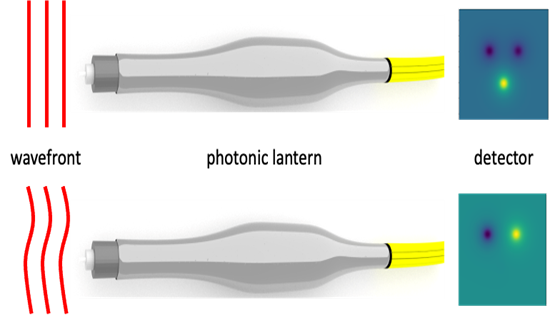Photonic Lanterns
Key components for astrophotonics applications from beam combiners/separators to wavefront sensors to quantum-inspired imagers
PL Concept
A photonic lantern is a monolithic optical fiber device consisting of a smooth continuous 3-D waveguide transition which implements spatial transformations. It accepts a multimode wavefront/image and converts it into an array of spatially separated single mode beams at high (>90%) optical efficiency. The lantern performs mode mapping equivalent to a transfer matrix operation from the multimode fiber modal basis to a basis consisting of an array of Gaussian beams.

Photonic Lantern Taper Evolution
(Top) Conceptual layout. (Middle) Cross-section microscope images of a 100-port CREOL-fabricated photonic lantern along its length. (Bottom) Waveguide mode diagram along the length. Blue corresponds to core (high performance) modes; red depicts cladding (lossy) modes.

CREOL Lanterns
(Top) Microscope images of a selection of photonic lantern fabricated by our team. Note that we regularly fabricate lanterns with mode counts sufficient for this work. (Bottom) Bare photonic lantern above a packaged and connectorized version of the same lantern.

Lantern Fabrication
We fabricate our photonic lanterns by fusing and tapering different fibers and glass capillaries together in our state-of-the-art Fiber Microdevice Facility at CREOL, producing lanterns that move from a multimode fiber input to an output array of isolated single-mode fibers. On one side, the lantern starts as an array of isolated uncoupled single-mode fibers which are then fused and tapered down.

